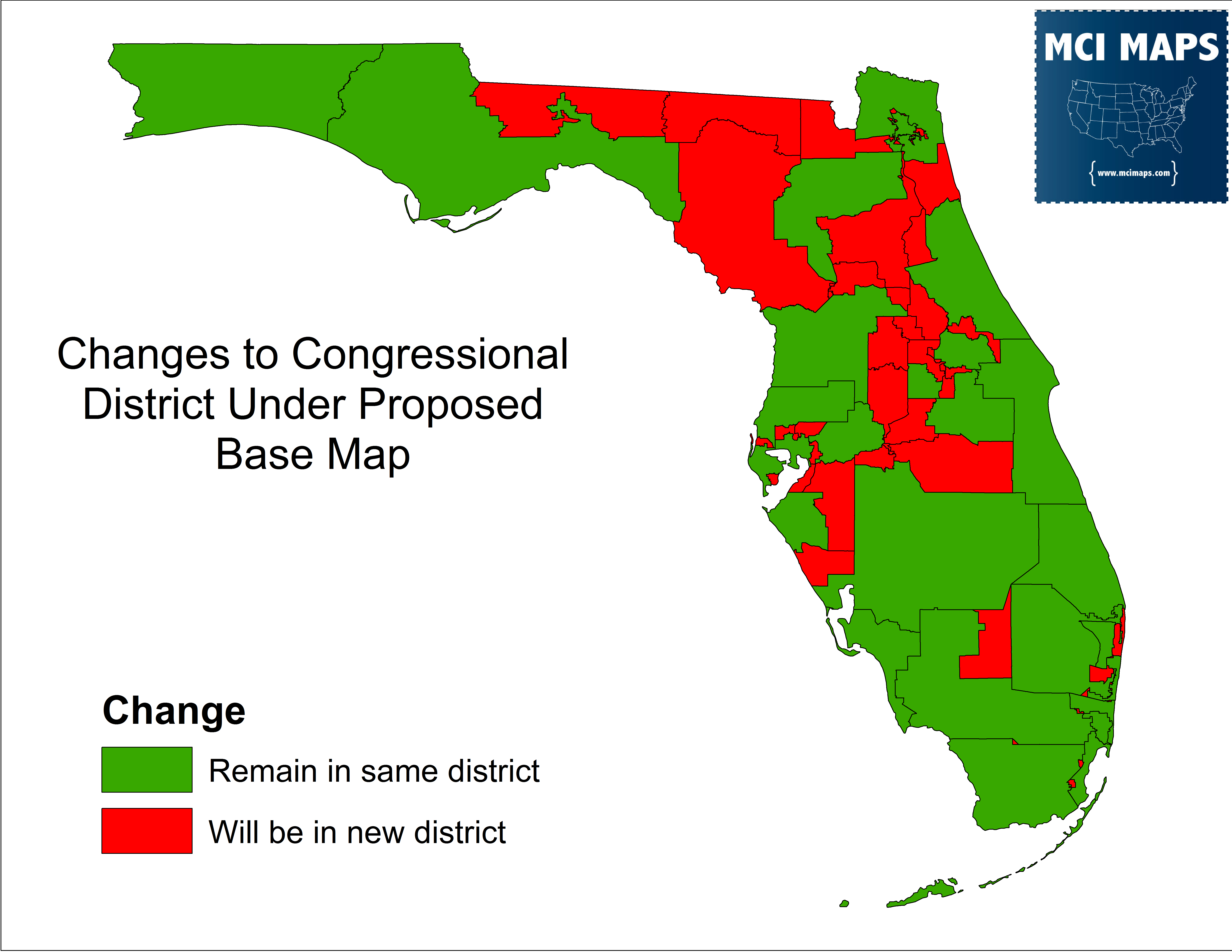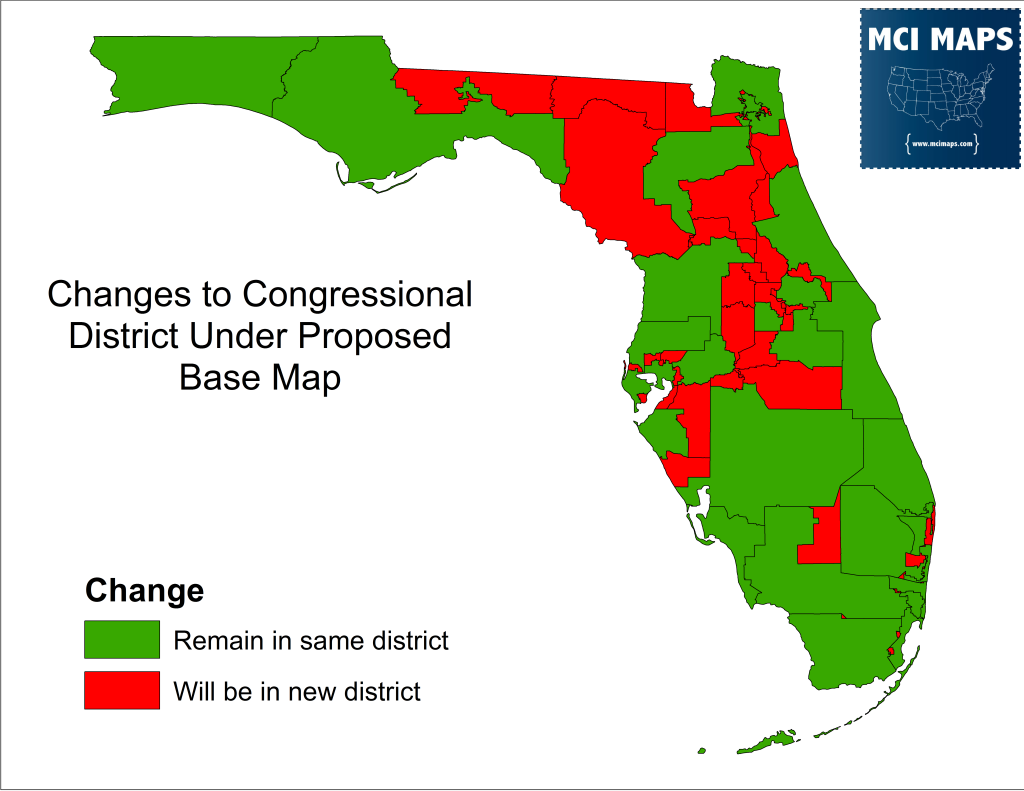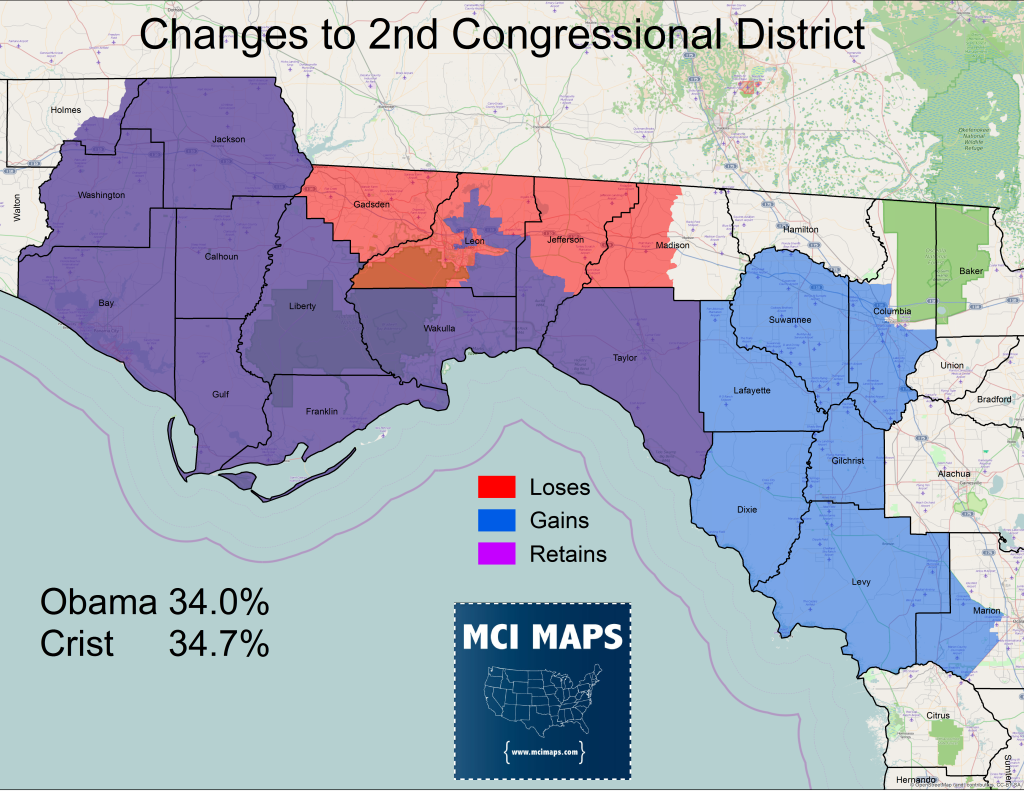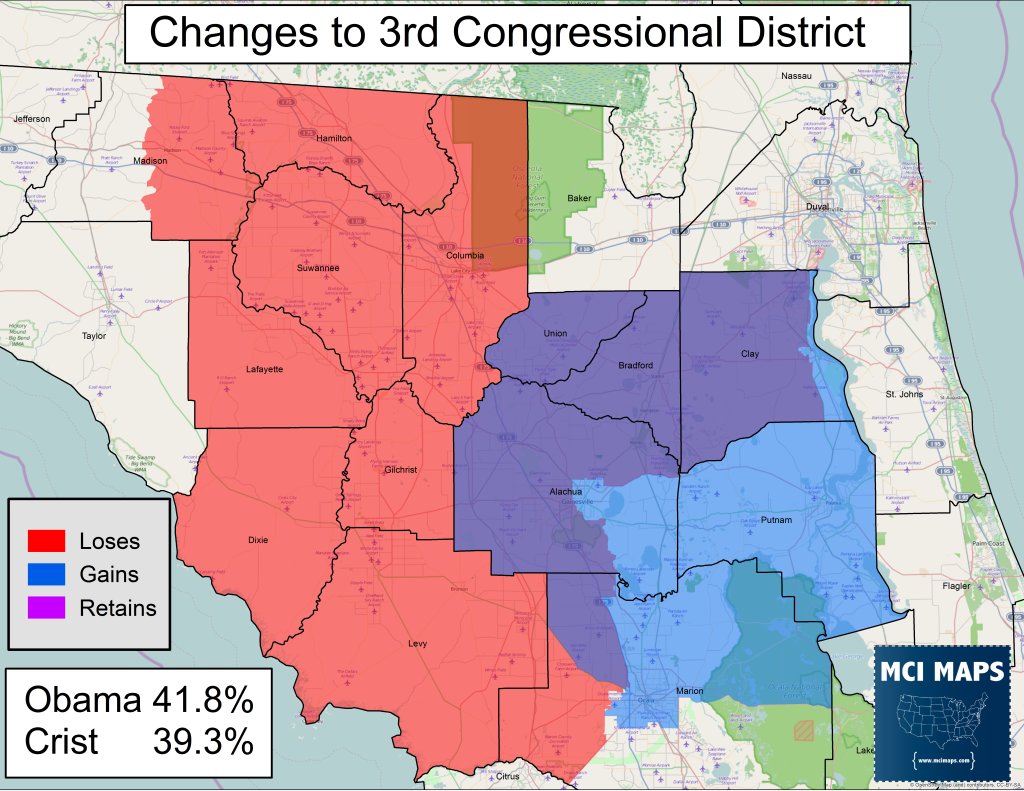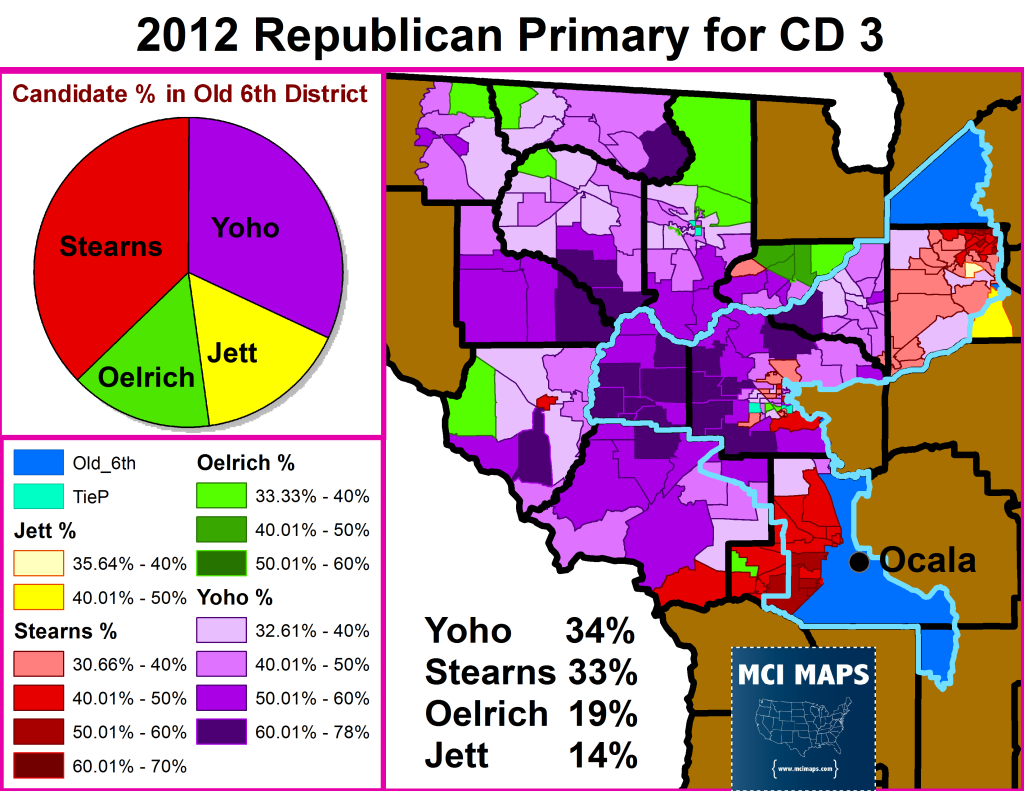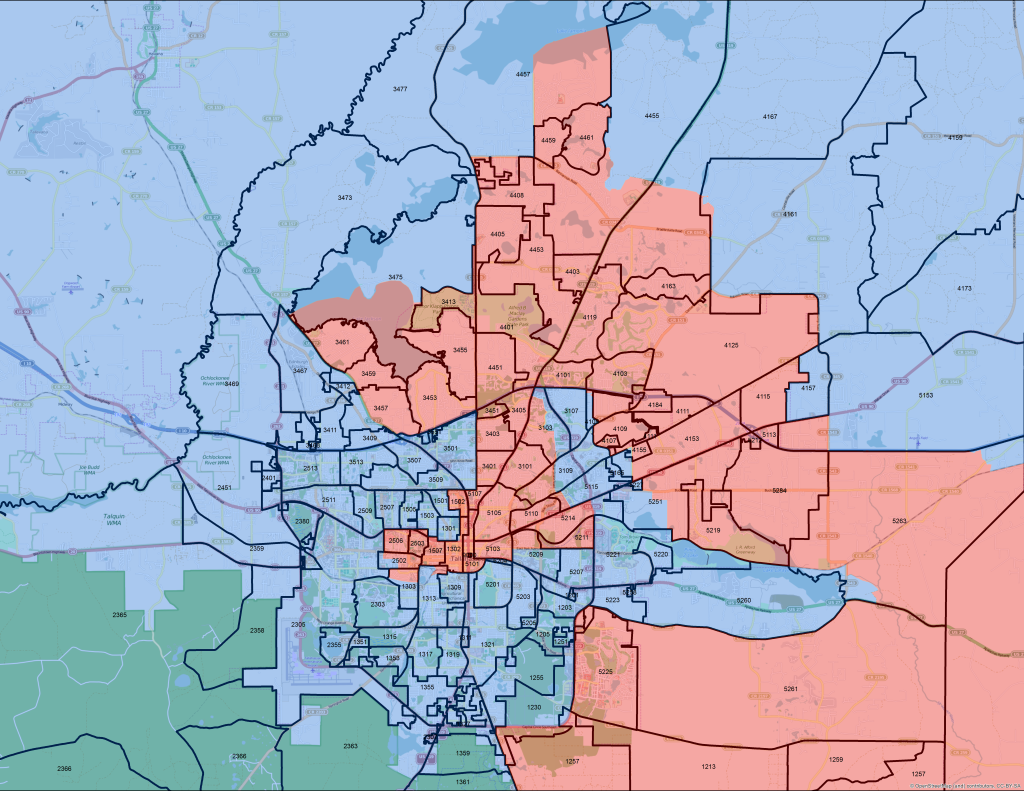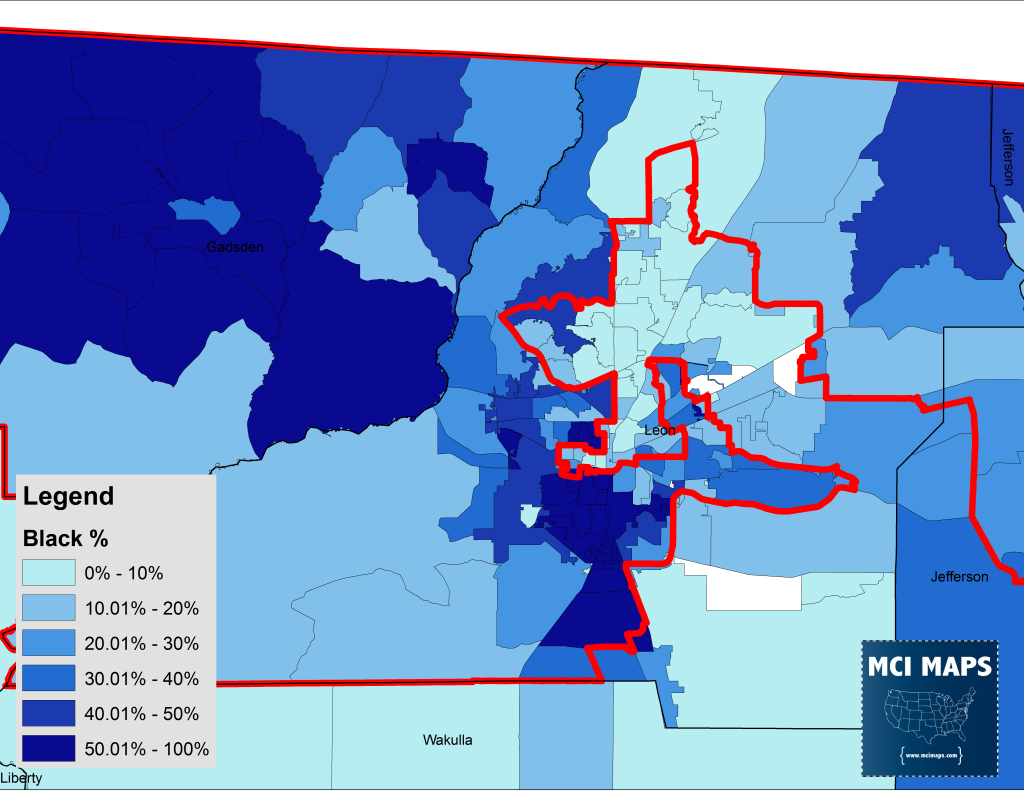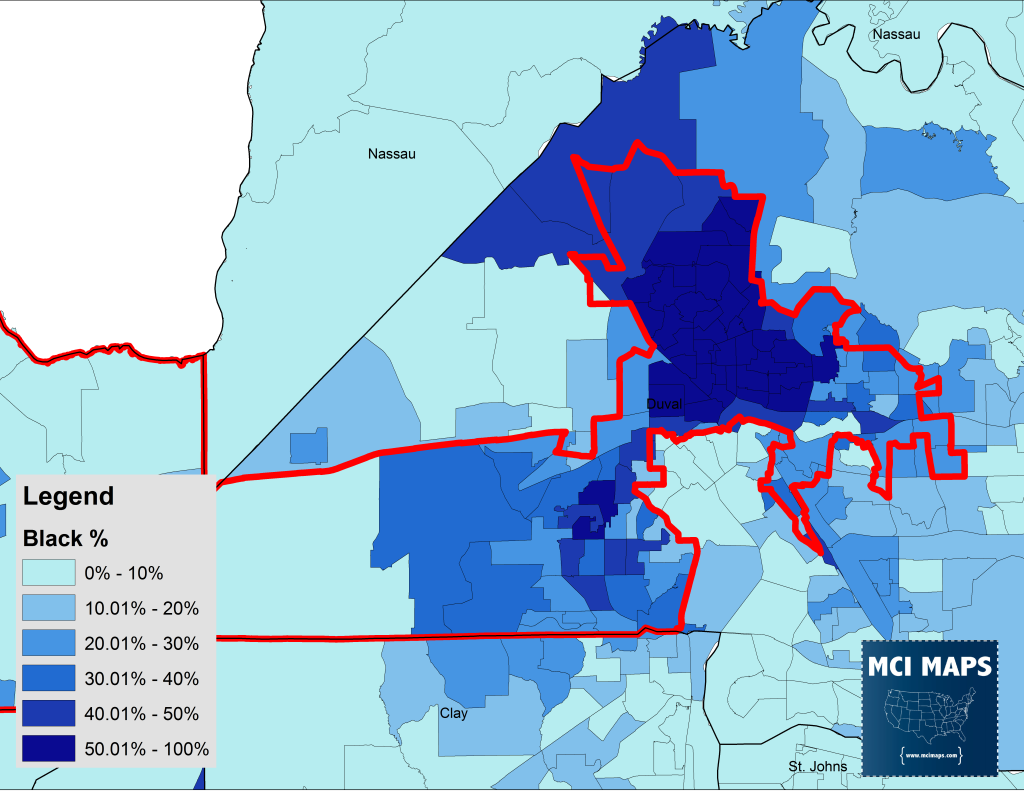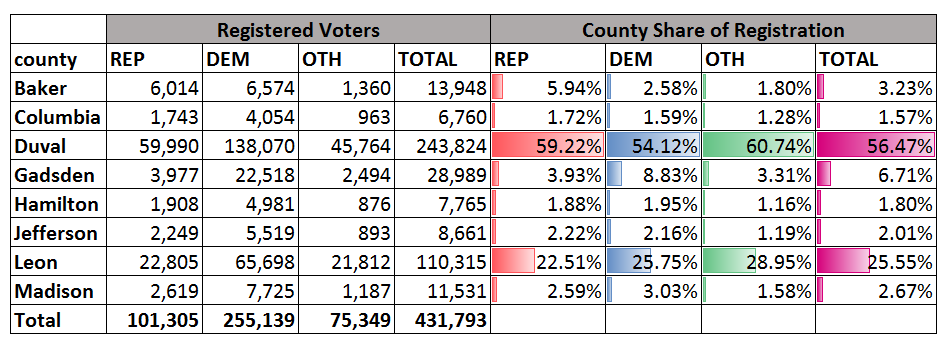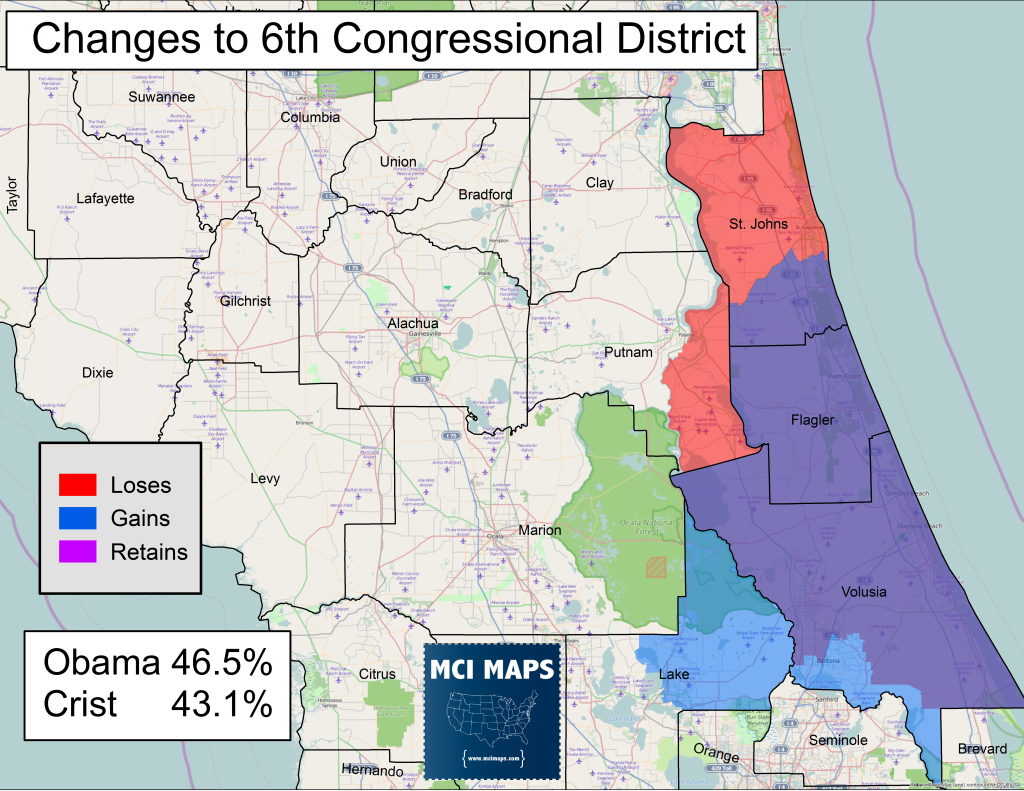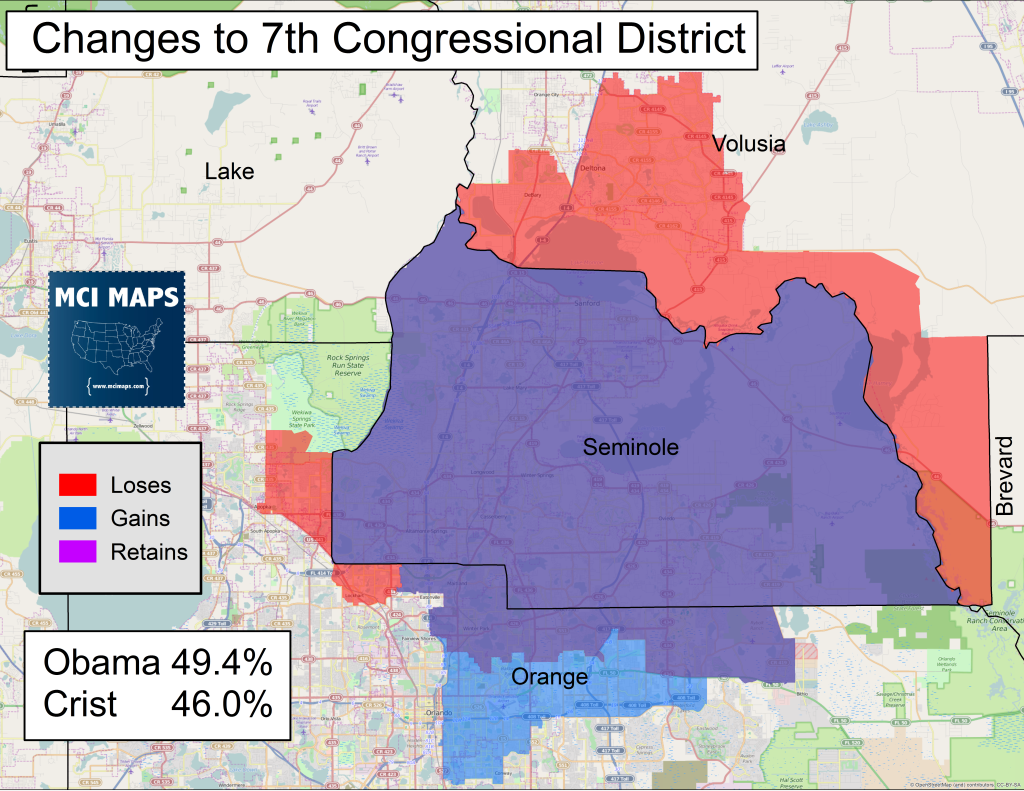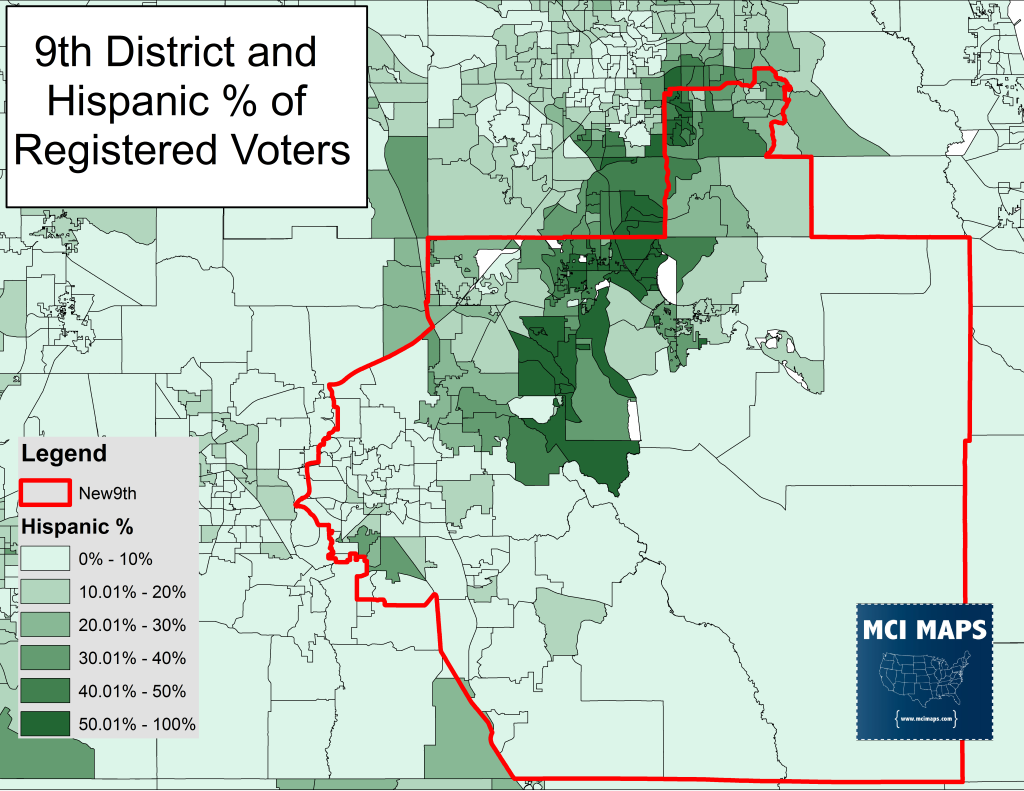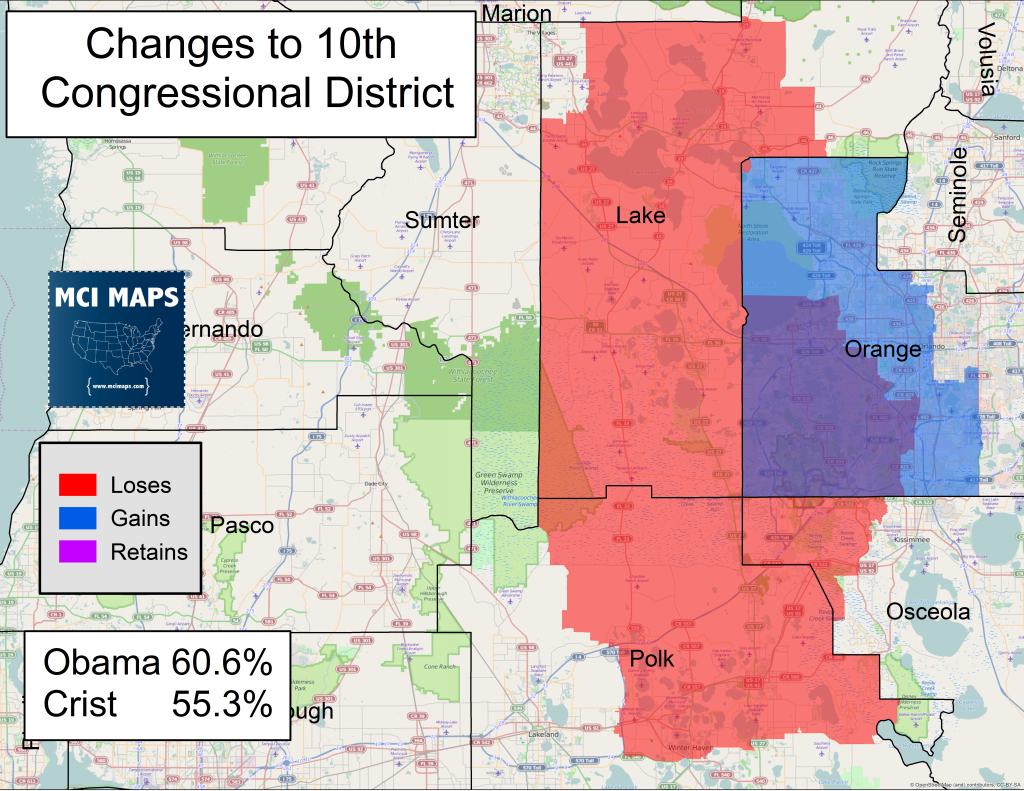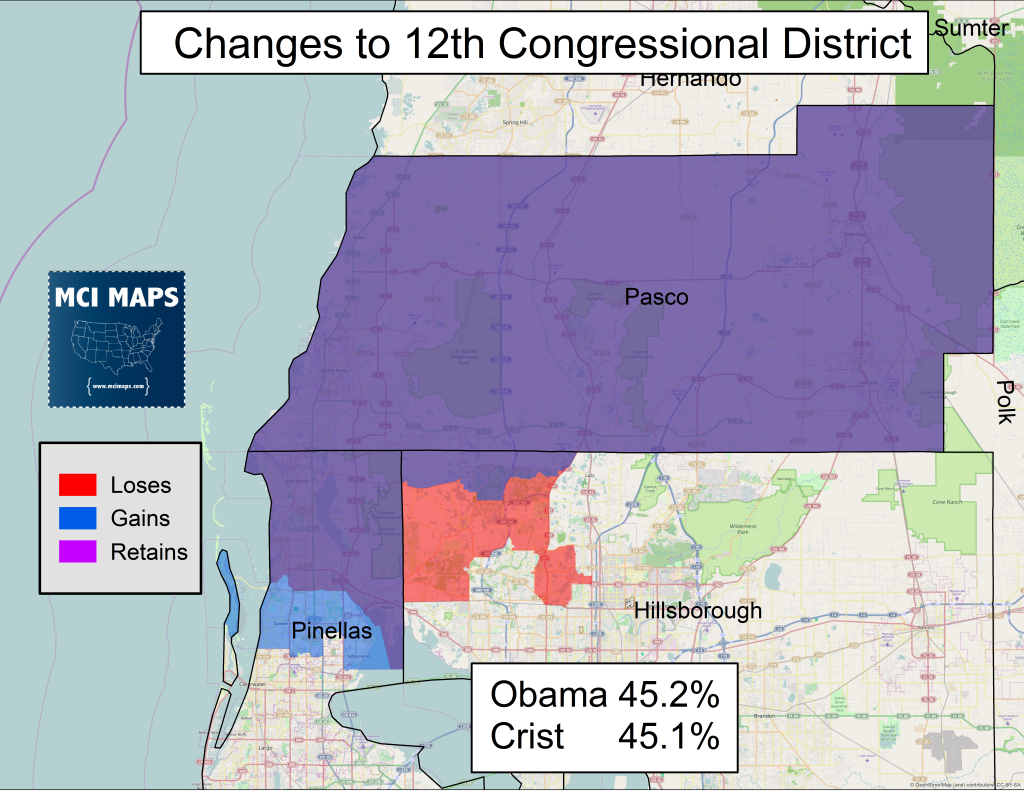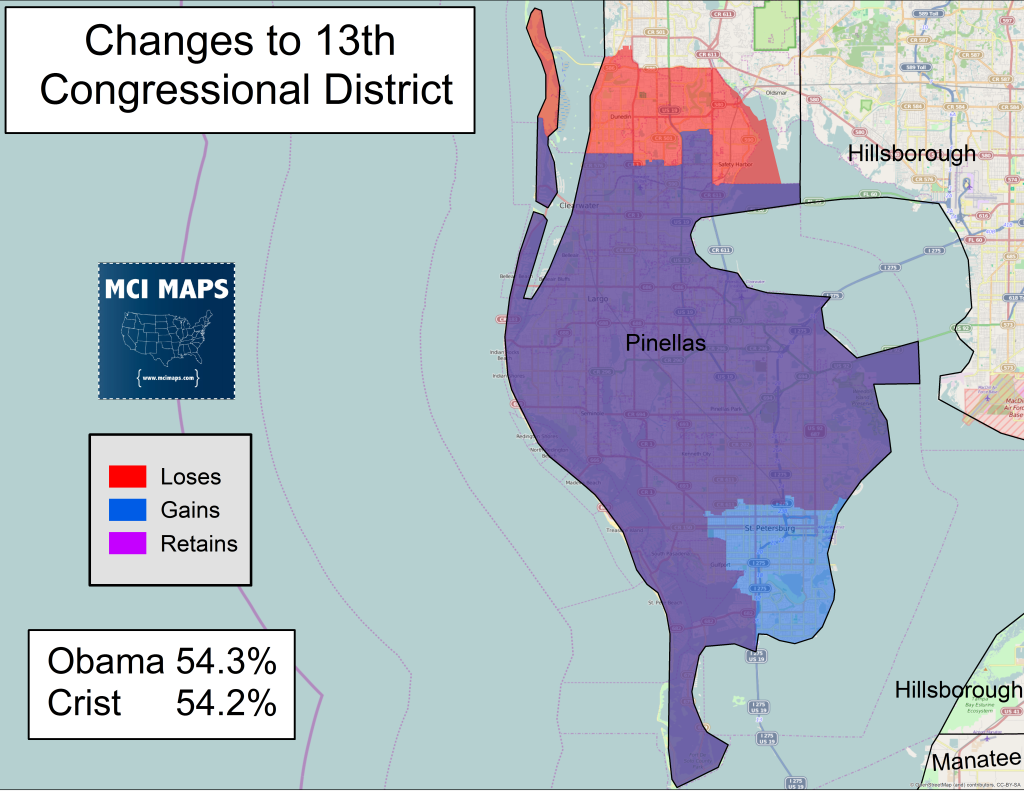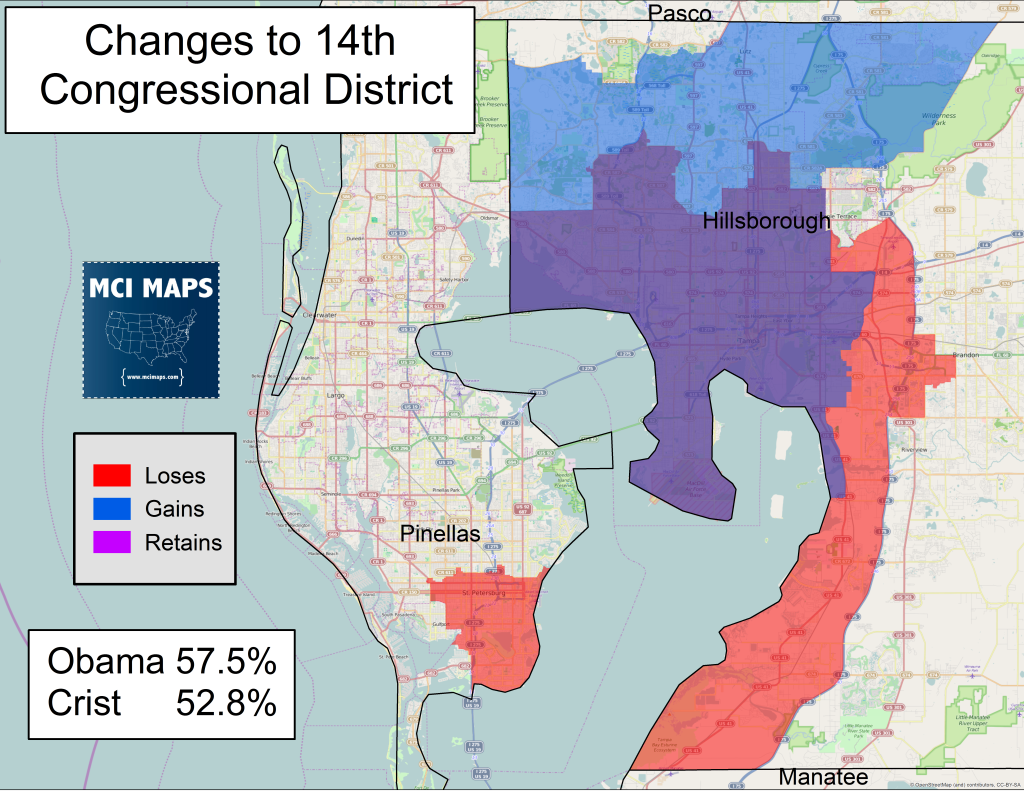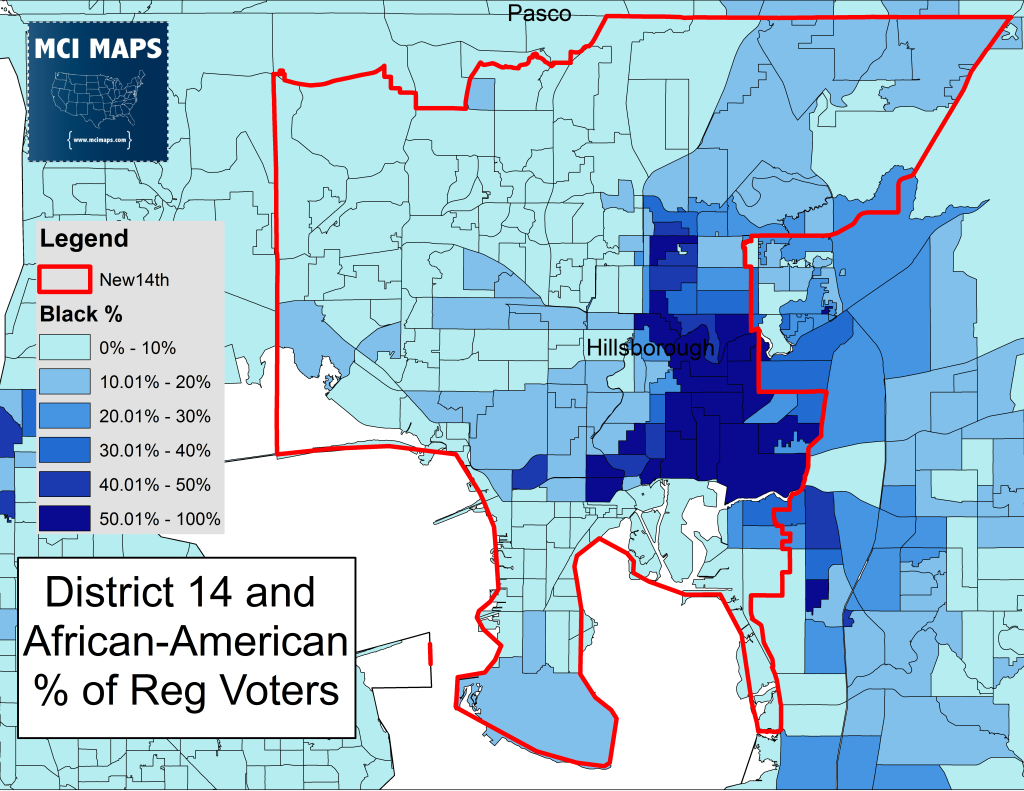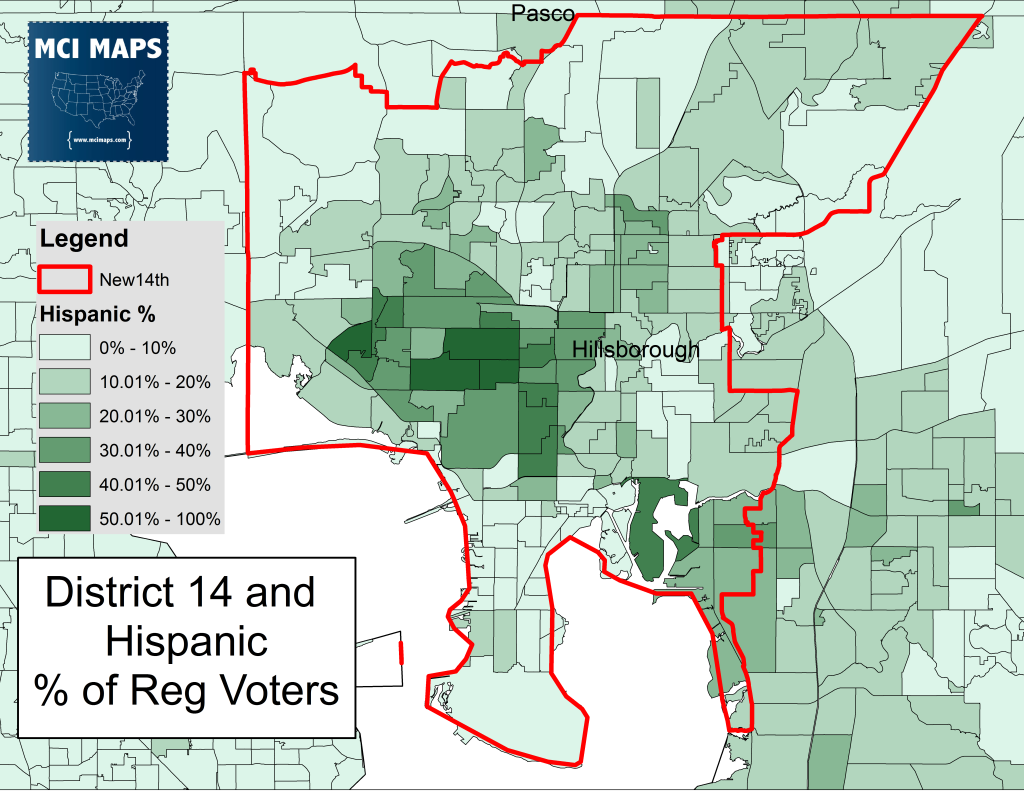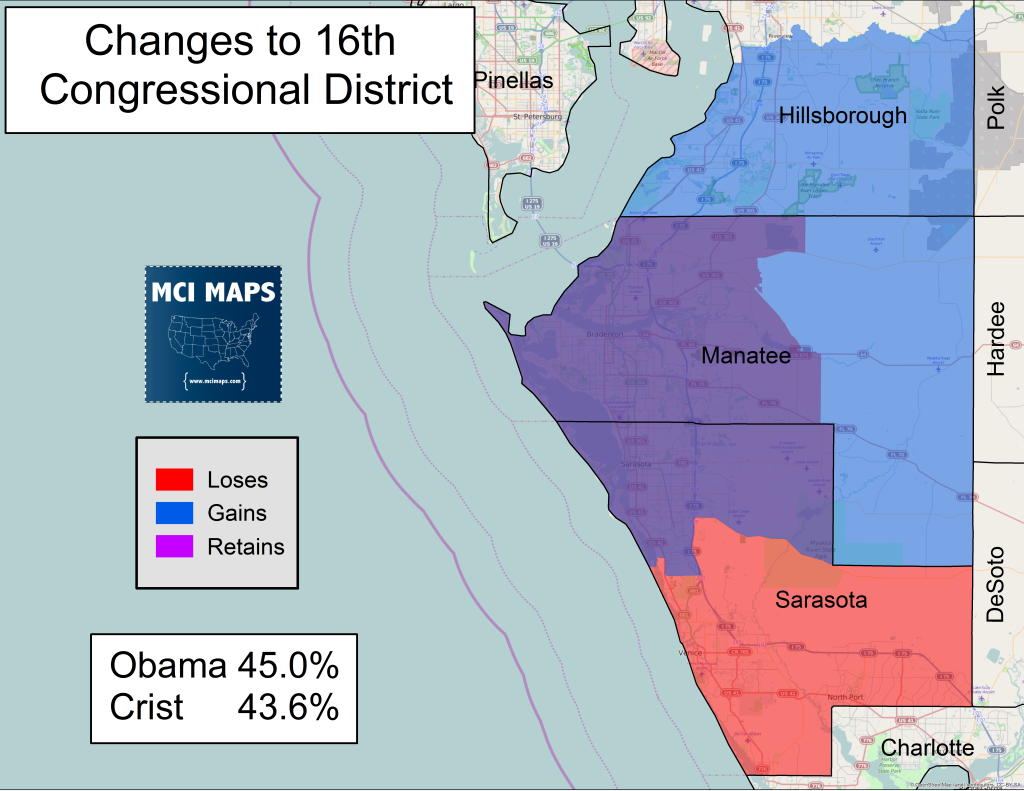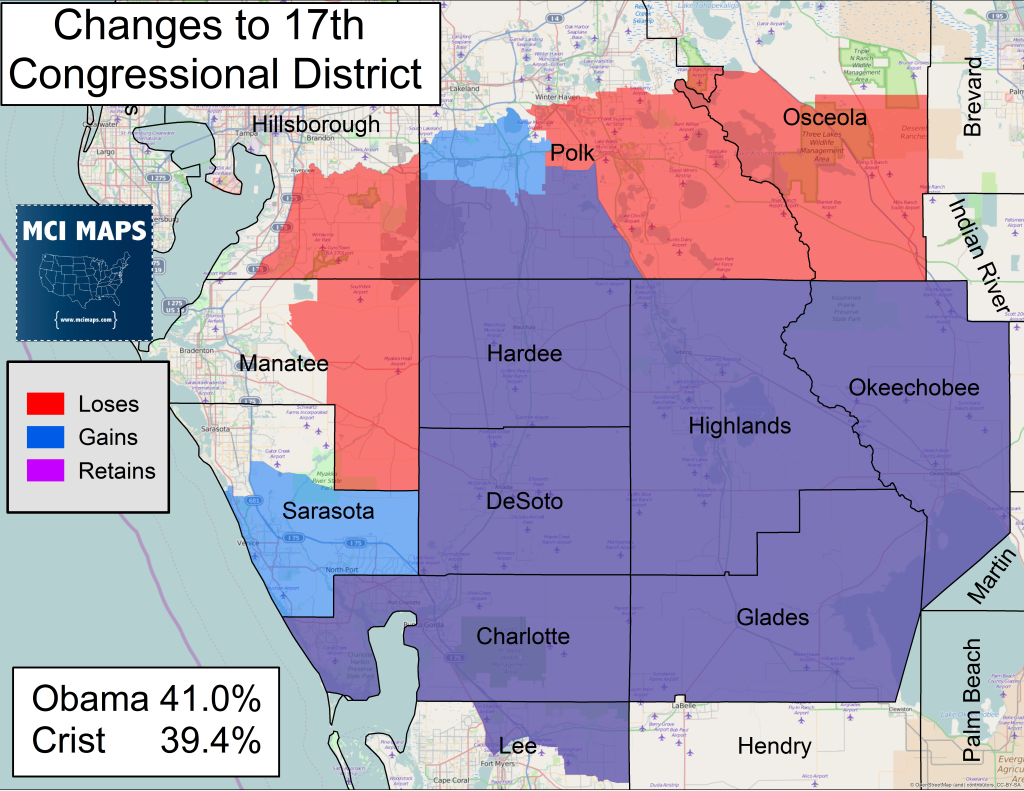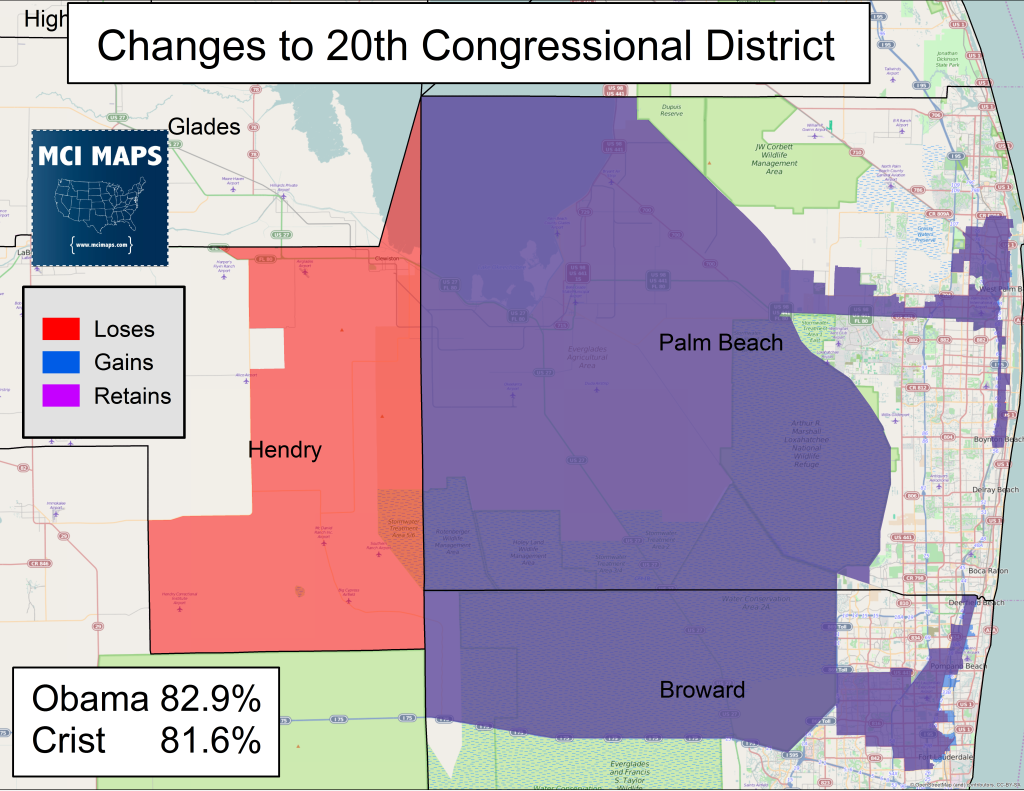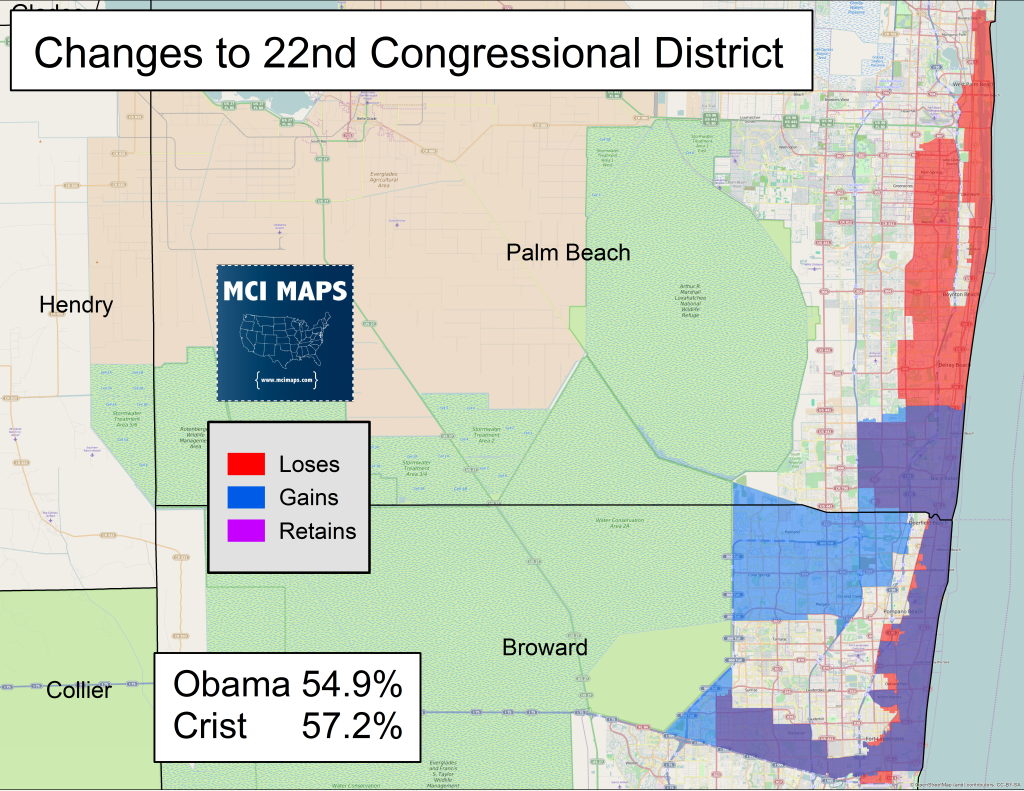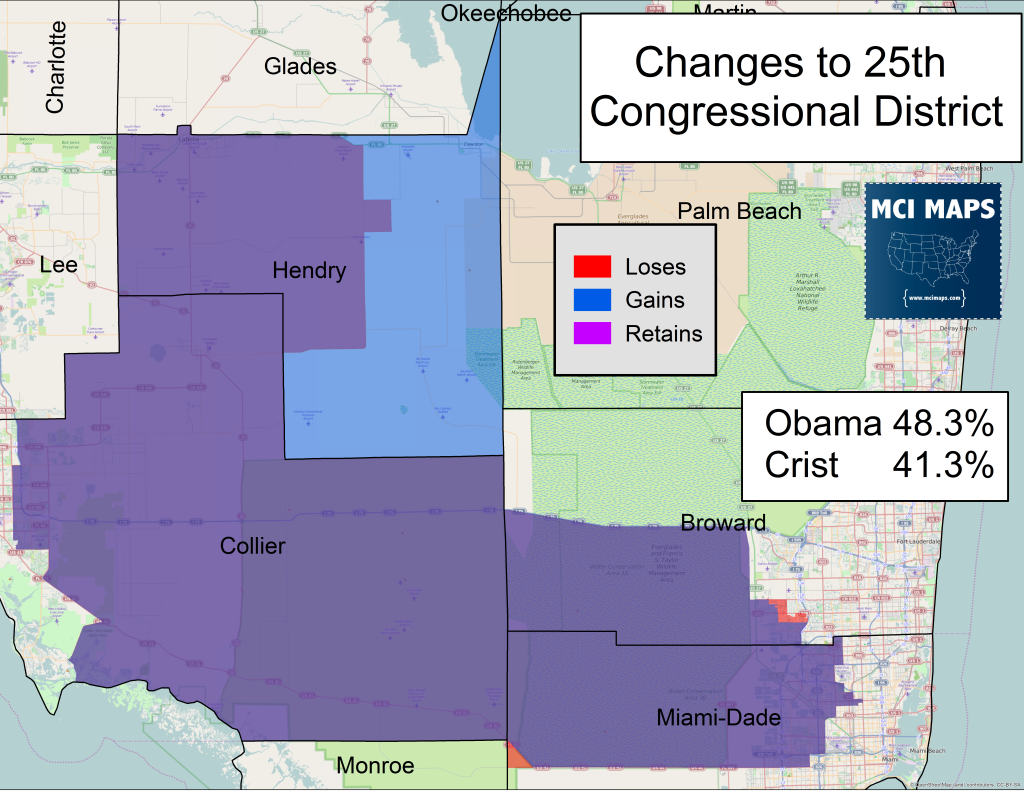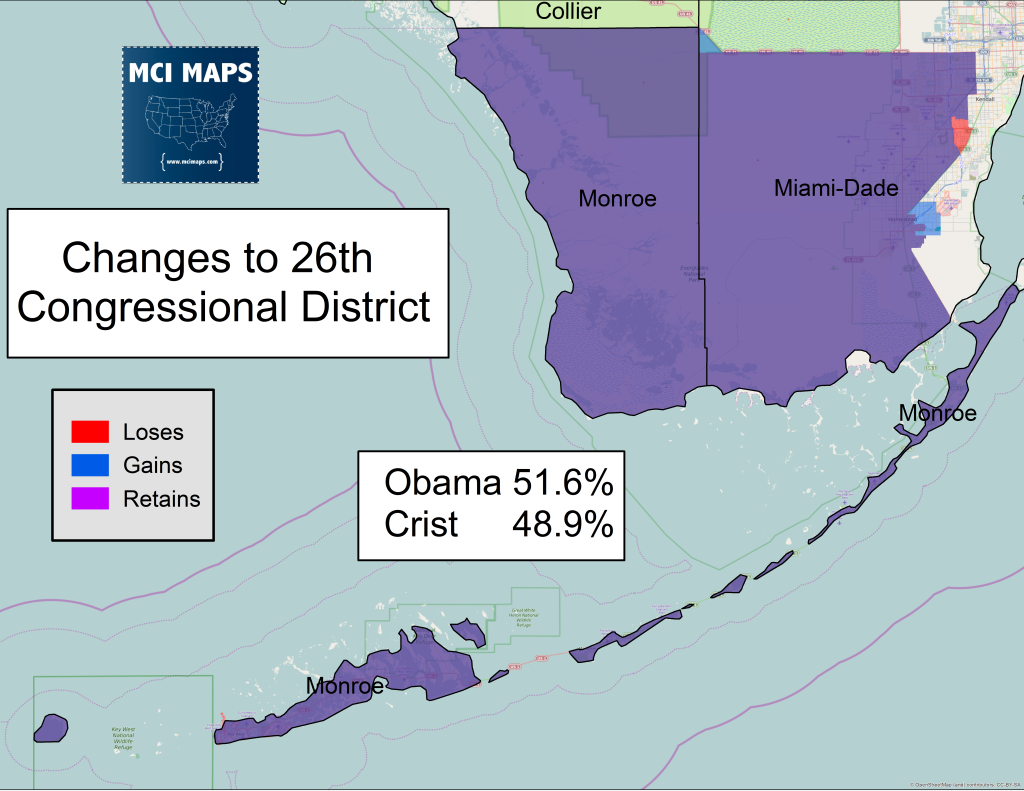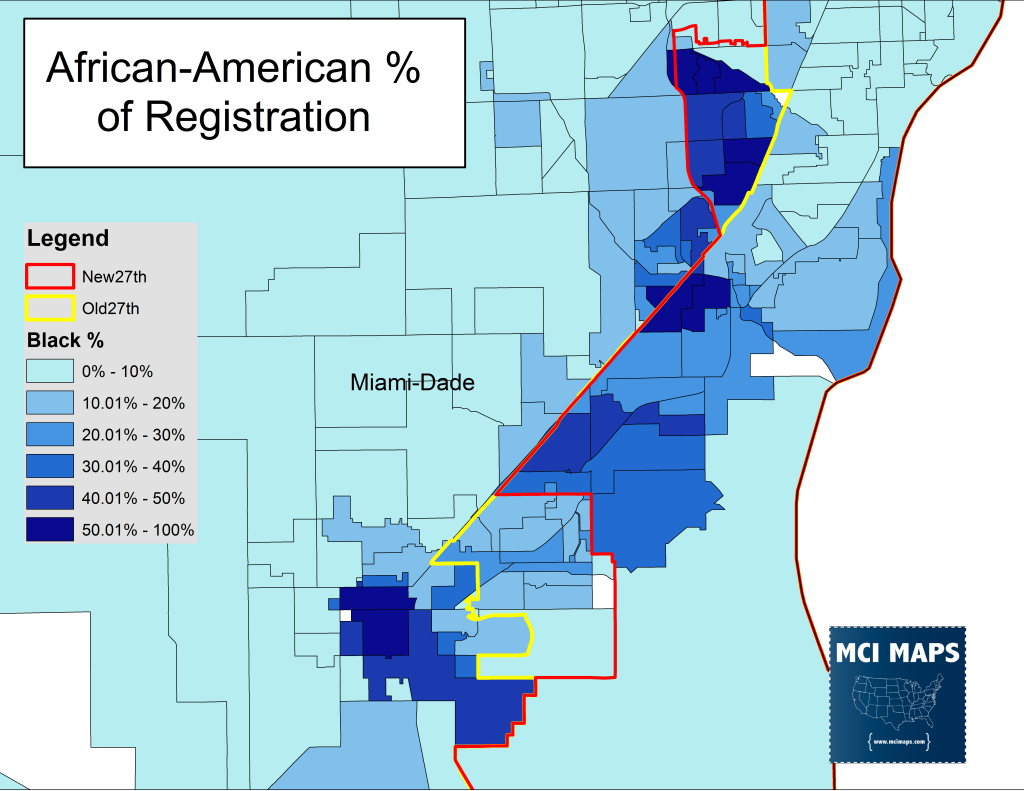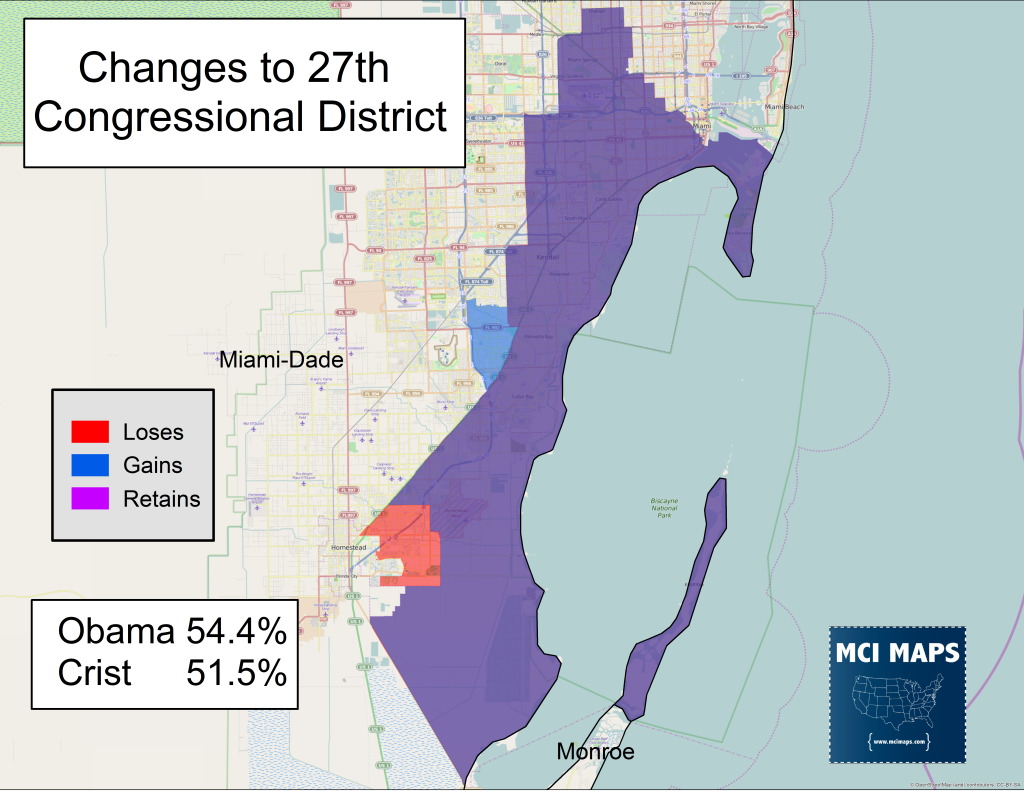The Florida Legislature released its base map heading into next week’s Special Session on redistricting. The map makes changes to 22 of the 27 districts. Some changes are small while others are very large. Many voters will find themselves in brand new districts if the base map becomes law. The map below shows areas that will change districts and those that will remain the same.
As the map shows, many folks (those in the red) will find themselves in new congressional districts. Even those who remain in the same district will likely see the nature of their district change.
The partisan effects on these districts slightly benefits Democrats. Gwen Graham’s district gets carved apart and CD 2 becomes very Republican, netting the GOP a seat. However, District 13 and 10, held by Jolly and Webster, become very Democratic and are likely pickups for Team Blue. This results in a net gain of one district for Democrats.
The state’s redistricting site offers the estimated presidential vote from 2012 for the new districts (as well as the old). I have attached the presidential totals for the current districts and the new districts. However, it should be noted that due to a large number of precinct splits, exact calculations are impossible. I included another Obama % (alternate) which reflects calculations I made based on how I assigned the split precincts. In many districts the difference is minimal, in others it is higher (those with more split precincts).
Overall the fluctuation is never more than a few tenths of a percent. I also personally calculated estimated gubernatorial numbers from 2014. Again, due to split precincts, these are estimates and they also factor in all third-party and write-in votes. The gubernatorial numbers are rough estimates that could fluctuate (thanks to split precincts) by a few tenths of a percent with a deeper dive. This is meant to be a general view.
Democrats see improvements in some districts and losses in others. Many districts saw very minimal partisan change. Democrats improve their showings in CD 7 (Mica) and CD 27 (Ros-Lehtinen) while losing votes in CD 14 (Castor) and CD 9 (Grayson). They have a few more competitive seats with this map, but the delegation remains in GOP control.
I have gone through each district and done a write-up on how they have changed. Several proposed districts look good. Others have major problems.
District 1
Jeff Miller’s solidly-Republican district was one of just a handful to see zero changes. The district is based in the western end of the Panhandle and will remain safe for the incumbent.
District 2
District 2 undergoes massive changes. In order to create a Jacksonville to Tallahassee district, CD 2 loses Gadsden, half of Leon, most of Jefferson, and the part of Madison it held. In order to balance the population, it takes in seven more counties: Suwannee, Lafayette, southern Columbia, Gilchrist, Dixie, Levy, and western Marion.
This new district is heavily Republican, giving Obama around 34 percent of the vote. Even Bill Nelson, one of the few remaining Democrats to do well in the Panhandle, only received 44 percent. Gwen Graham resides in this district but has little chance of winning it if she runs. She faces the double-whammy of losing Democratic areas and adding many new, heavily conservative areas that have no reason to support her.
The largest population bases are Leon and Bay. Bay has the advantage over Leon, holding more registered Republicans than Leon. Bay has 31 percent of the Republicans in the seat to Leon’s 18 percent. The rural counties would need to have a unified force to elect a representative of their choosing.
There is a major problem with splitting Tallahassee, but I will address that in District 5′s analysis.
District 3
Ted Yoho’s district undergoes massive changes. Yoho loses many of the rural counties that propelled him to his primary upset in 2012. Meanwhile, Yoho takes in the rest of Alachua and Clay, Putnam, and northern Marion.
Compare the map of what he loses to his primary win in 2012 over Cliff Stearns. One of the reasons Stearns lost was due to 2012′s redistricting and losing parts of his base (Ocala). Ironically, Yoho finds himself in a similar position.
Yoho loses some of Marion that didn’t back him, retains Clay, and loses many bases of support. In such a GOP district, Yoho is only vulnerable to a primary, if a serious one emerges. Yoho could hold on and entrench himself. However, the establishment has no love for him and a strong challenger could make it interesting. The three biggest GOP bases are Clay (40 percent of the district’s Republicans), Alachua (25 percent) and Marion (21 percent).
District 4
Ander Crenshaw’s district loses Baker and part of Duval to the new 5th district and takes in northern St. Johns to balance the population. The district should remain safe for Crenshaw and any Republican. The addition of St. Johns will give a Republican from that area an opening to run in the future.
This district remains one of the most Republican in the state.
District 5
The Legislature followed the court order by drawing Corrine Brown’s 5th Congressional District east-west. The district goes from Duval, takes Baker, Hamilton, Madison, northern Jefferson, half of Leon, and Gadsden. The district is 45 percent African-American. Meanwhile the district loses everything south of Duval.
The district’s main problem is that it splits Leon County. As I demonstrated here, the district can retain African-American status and keep Leon whole. Under this map, Tallahassee is carved to pieces as African-American areas and some white neighbors are added into the 5th district. The Leon County map below shows the areas that will be in CD 5 (blue) and CD 2 (red).
The two maps below show the district taking in African-American areas in Tallahassee and Jacksonville. Many precincts are split in the process.
Corrine Brown will be favored in this district. The seat is heavily Democratic and 66 percent of the registered Democrats are African-American. 55 percent of the Democrats in the district come from Duval, which is actually less than in the League of Women’s Voters’ proposed map. Leon, down at 25 percent of Democratic voters, has little chance of influencing the district.
Many members of the Leon delegation have expressed a desire to keep Leon whole in CD5. This will be a debating point when the special session begins.
District 6
District 6, left open due to DeSantis running for U.S. Senate, undergoes several changes. The district loses northern St. Johns to CD 4 and the bit of Putnam it had to CD 3. The district then takes in parts of Marion and Volusia to balance the population.
The district remains Republican favored, albeit less so than under its current lines. Under the current boundaries, St Johns and Volusia had the same number of GOP voters. However, with Volusia being made whole and St. Johns being split, the Republican base shifts more to Volusia.
District 7
Mica’s 7th district undertakes some very surprising changes. The district loses southern Volusia to CD6, losing Deltona. However, it is the parts of Orange that it takes in that are surprising.
The district loses some parts of Orange on the west but then moves south to take in a good deal of eastern Orlando. Many of the precincts it absorbs have significant Hispanic populations and currently reside in CD9, a Hispanic access seat. These changes makes the district much more Democratic, going from 47 percent Obama to over 49 percent. However, the taking in of Hispanic voters may become an issue in the special session and under court order. Mica’s district becomes bluer, but he is still a favorite for re-election.
District 8
District 8 had no changes and should remain safe for Bill Posey.
District 9
There is no way around this. There are many problems with District 9. The district, being vacated by Alan Grayson, loses many of its Hispanic voters, falling to 30 percent Hispanic (32 percent if you include Hispanic blacks in the figure). When the district was drawn in 2012, it was 39 percent Hispanic and 41 percent if Hispanic blacks were included. The district becomes much whiter thanks to losing Hispanics in Orange and gaining whiter areas form Polk.
The district becomes less Democratic, falling from 60 percent Obama to 55.9 percent. What is especially notable is that in the midterms Crist fell to 48.1 percent (though he won with Scott getting 46 percent). Alan Grayson would not be able to hold the seat in a midterm.
When looking at the Hispanic registration in the area (which tends to under-perform total population) compared to the new boundary, it is clear many Hispanics could be added into the seat.
The boundary seems to go out of its way to take in white areas of eastern Polk while losing heavily Hispanic areas in south Orange County. The Hispanic population is unnecessarily split and the seat is no longer an access seat for the community. This must be addressed in the special session. Otherwise, a lawsuit will follow and the Supreme Court may not approve the boundary.
District 10
If one Republican congressperson was going to be sacrificed, I predicted it would be Webster. Webster, whose district is currently around 47 percent Obama, angered the GOP establishment with his challenge to Boehner for the speakership. With African-Americans from CD 5 needing to go somewhere, Webster seemed like the likely candidate. The extent to which he was thrown overboard though is staggering. The district takes in the African-American voters of CD5 and many Hispanics of CD 9. Meanwhile, it loses Republican-friendly Lake. The district becomes heavily Democratic, giving Obama 60 percent of the vote.
The district, which used to be over 60 percent voting-age population white, is now 44 percent white, 25 percent black, and 21 percent Hispanic. For someone like Val Demings, the district is a perfect opportunity. Many other Democrats may look at the seat now as well. However, as I mentioned with CD9, there is an issue with the Hispanic population. CD 10 may need to give Hispanics back to CD 9 and take in other areas. The end result should be a Democratic district, but less than this proposal. Because of possible changes to CD 9, CD 10′s boundaries may likely change. Regardless, Webster is in deep trouble.
District 11
Richard Nugent’s district undergoes some changes as it loses Ocala to CD 3 and picks up parts of Lake from CD10. The district remains reliably Republican.
The district should not present any real problems for Nugent, who hails from Hernando County.
District 12
District 12 also undergoes some slight changes, taking in parts of Pinellas from CD 13 and evens out the population by losing parts of Hillsborough.
The district is still modestly Republican and Gus Bilirakis will have no trouble with re-election.
District 13
David Jolly saw the writing on the wall after the Supreme Court’s redistricting decision. With CD 13 being forced to take in African-American St. Petersburg, there was little chance the district wouldn’t become much more Democratic. As predicted, the district took in the African-American areas and lost some of its northern precincts, largely retaining Clearwater on its Northern end.
With Charlie Crist publicly expressing a desire to run for the seat, the district is a likely Democratic pickup. With polls showing Crist solid in the primary and general, it is a very good chance Crist will make a comeback with this congressional run.
District 14
District 14 sees changes as it loses the African-American parts of Pinellas and gains many communities in the North. The district almost makes Tampa completely whole. However, the boundaries may run into problems on racial grounds.
District 14 remains Democratic, albeit less so than before. However, the real issue for the seat is the changes in its demographic makeup. The district was originally drawn as a minority access seat: with 46 percent of the voting age population being white, 24 percent black, and 24 percent Hispanic. However, under these lines the district is 52 percent white, 17 percent black, and 24 percent Hispanic. Now the African-American share was going to fall due to the loss of South Pinellas. However, many areas with significant Hispanic and black populations are left out of the seat while whiter areas are taken in.
The district could move east to take in the community of Brandon, and maybe even Plant City, while losing some of the whiter areas in the west (giving them to CD 12 or CD 15). In fact, the district 15 seat could take in many of the northern Hillsborough areas and could go further west to take in more of them. The split to Tampa could be minimized (it still isn’t entirely whole in this proposal). As two of my proposals show, it is possible to draw the district keeping the white voting age population under 50 percent.
District 15
District 15 undergoes some major changes. First it takes in the part of Lake taken from Webster’s district, then it takes parts of Hillsborough around the Brandon areas, gives up the Northern Tampa area, and loses parts of Polk.
The new district is still modestly Republican. However, Ross will have many new voters. However, he should be fine for re-election, as only around 40,000 new Republican join the district and 120,000 remain in the area he already represents. However, with the issues I laid out in District 14, the 15th may need to give up the Brandon area and take in some more of northern Hillsborough.
District 16
Vern Buchanan’s seat is undergoing a surprise change as it loses Southern Sarasota and takes in parts of Hillsborough.
Buchanan’s district seems to swap areas with CD 17, seemingly for no clear reason. Much of the Hillsborough area gained by 16 is taken from 17, as is eastern Manatee, while 17 takes southern Sarasota County. Buchanan should be favored in this Republican seat, which includes his base in North Sarasota. He retains more GOP voters than he takes in. However, there may be significant debate over the seemingly unneeded split of Sarasota County.
District 17
Tom Rooney’s safe Republican seat doesn’t get any more competitive. However, some of the changes to the district are questionable. As discussed with CD 16, the splitting of Sarasota seems unnecessary. The district now includes Southern Sarasota, while giving CD 16 a good chunk of Hillsborough. The district also trades areas of Polk while losing the low-populated region of Southern Osceola.
The tradeoff of Sarasota and Hillsborough with CD 16 is the biggest issue here. Regardless of any changes, Rooney, based out of low-populated Okeechobee County, has never had a tough time getting re-elected. However, I believe there will be debate over the splitting of Sarasota. Regardless, Rooney is very likely safe from any primary.
District 18
District 18, based out of St. Lucie, Martin, and Northern Palm Beach, has no proposed changes. The seat will be heavily fought over by both parties in the fall.
District 19
District 19, held by Republican Curt Clawson, also sees no changes. The seat remains safely in the GOP column.
District 20
Alcee Hastings’ district undergoes very minor changes. The Supreme Court ordered Hendry be made whole in a district, and this map opts to make it whole in CD 25. The population of Hendry is very low and it only takes a few added precincts in Broward to even the population out.
The district remains 50 percent African-American (48 percent if you don’t count Hispanic blacks) and is heavily Democratic.
District 21
When the Supreme Court ordered Districts 21 and 22, Democratic seats held by Ted Deutch and Lois Frankel respectively, be redrawn in a more compact manner (while maintaining District 20′s African-American majority), the prospect of both members ending up in the same seat was high. The current districts both split Palm Beach and Broward, running parallel to each other.
The court advocated, but did not demand, stacked districts. Indeed, under the proposal submitted, District 21, based out of Palm Beach, is stacked on top of District 22, which includes Boca and parts of Broward. District 21 contains the homes of both Deutch and Frankel. Frankel lives on the northern end of the district, while Deutch lives in the eastern neighborhoods outside Boca in the southeast end of the district.
The seat retains a great deal of Deutch’s current district, loses the parts that were in Broward, and takes in the northern half of Frankel’s 22nd district.
Deutch lives very close to what will be the new 22nd district, just miles north of the Broward line. Frankel, meanwhile, lives much further north and would face trouble running in a district much further south that she does not live in. Frankel is also a well-known institution in Palm Beach County, with a long career in the state Senate, Mayor of West Palm Beach, and now Congress. However, 63 percent of the Democrats in the proposed district are in Deutch’s current seat. Deutch also commands a very loyal following, especially in the Jewish community, and Frankel cannot easily take his voters to win a primary. If both ran for the seat, it would be a titanic primary. While I initially believed Frankel would be heavily favored, it appears Deutch would have an edge due to representing more voters and those voters remaining very loyal to him.
District 22
With District 21 taking in much of the northern end of this current district, 22 ends up based much more out of Broward, taking in the Broward areas Deutch represents now and taking in white areas surrounding CD 20. The district also retains Boca, giving it some ties to Palm Beach County.
Both Frankel and Deutch will at least look at running for this seat. For Deutch, the Broward area he currently represents that will be in this district has many condo areas with large Jewish populations that would likely be loyal to him. He would have to deal with the coastal and southern areas that don’t know him, but would likely start off with a moderate advantage. Frankel could also run here. However, she is likely to have less of a loyal following in Broward than Deutch commands. If a Broward politician challenged her in the primary, the Broward regions Deutch represents now would be up for grabs and the coastal and southern areas could swing away from her as well. Frankel will be coming all the way from West Palm Beach and that could become an issue. It is also worth noting that when Frankel won her primary in 2012 with 61 percent against Broward Commissioner Kristen Jacobs, they tied in Broward. A Frankel v. Jacobs re-match could yield very different results under the new lines.
There are also several other Broward politicians who could make a play for the seat. Frankel or Deutch may not get a primary to themselves if they try to run here (and it would be smart to make a decision quickly in order to stop a potential primary). If neither make the move south, then the seat could be a free-for-all of Democrats. State Rep. Kristen Jacobs may look at the seat. Meanwhile three members of the Broward Commission represent parts of the district: Mark Bogen (disclosure, I worked for his campaign in 2014) represents many of the heavily Democratic condos of the district, Stacy Ritter represents the northwestern neighborhoods of Parkland and Coral Springs, and Tim Ryan represents parts of the coast and south. There will be no shortage of options for Democrats here.
District 23
Debbie Wasserman Schultz’s district is undergoing minor changes. The district loses part of Sunrise to District 22 while taking in a few precincts of Pembroke Pines from CD25. The district also takes in a small portion of south Fort Lauderdale.
The seat remains safe for Democrats and the DNC Chair.
District 24
No changes were made to this heavily Democratic, majority-African-American district. U.S. Rep. Frederica Wilson continues to be a shoo-in for re-election.
District 25
Per the court order to make Hendry whole, District 25 took in the eastern half of Hendry while losing a few precincts in Pembroke Pines to even the population out.
The district has trended toward Democrats in presidential years. The district may get much more competitive if trends continue. However, the midterms did not go well in the district.
District 26
When the court ordered the Democratic city of Homestead be made whole (currently split between CD 26 and CD 27), many, including myself, thought they would give the city to CD 27 in order to make the 26th more Republican. Both seats are held by Republicans, but only U.S. Rep. Carlos Curbelo is being seriously challenged. Curbelo won his seat in 2014 and is a top DCCC target.
District 27 U.S. Rep. Ileana Ros-Lehtinen is very popular, liberal on social issues, and can afford to take in more Democratic voters. However, the map actually makes Homestead whole in CD26, giving the district more Democrats. However, the district also loses several heavily African-American precincts further north to even the population out.
The removal of the African-American precincts makes the district more Republican than it currently is, taking Obama’s % from 53 percent to 51.6 percent. Under current lines, the Crist/Taddeo ticket got 50 percent, now it has 48.9 percent (a plurality win with Scott getting 48.3 percent). Taddeo is running against Curbelo and does have a shot at taking the seat.
It should be noted how…. convenient… it is that the precincts moved to CD27 are so heavily African American. While 26 takes all of Homestead, it already had the African-American western side of the city. The African-Americans it loses in the north are much more Democratic than the rest of Homestead. The map below shows the African-American pocket that is transferred from CD 26 to CD 27. The new 27th boundary loops around and takes in the African-American voters.
District 27 does already have some African-American voters. However, the move of the pocket in the North seems like a clearly partisan move.
District 27
The changes to district 27 are already highlighted in district 26. Thanks to taking in the heavily African-American areas north of Homestead, the district becomes more Democratic. However, U.S. Rep. Ros-Lehtinen remains safe due to her personal appeal.
The second she retires, however, this seat will be a prime Democratic target.
Conclusions
With special session beginning next week, there is still a long way to go before anything is settled. Many districts are likely to be debated and challenged and no doubt some changes will take place. However, from this base map we can see the trend. Democrats will benefit from this map or any variation of it. However, the benefits are still limited and more work will need to be done for the party to win control of the congressional delegation.

